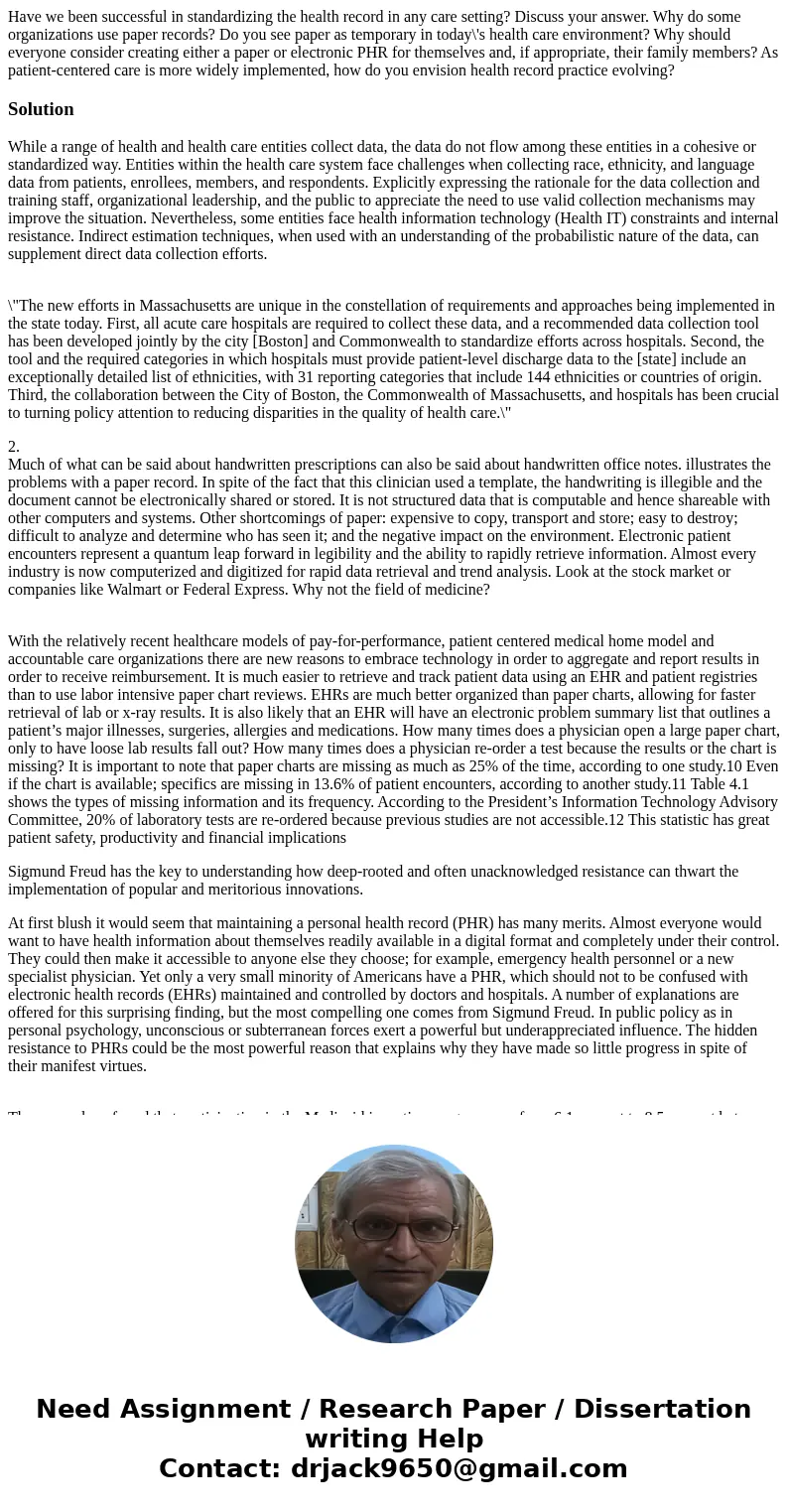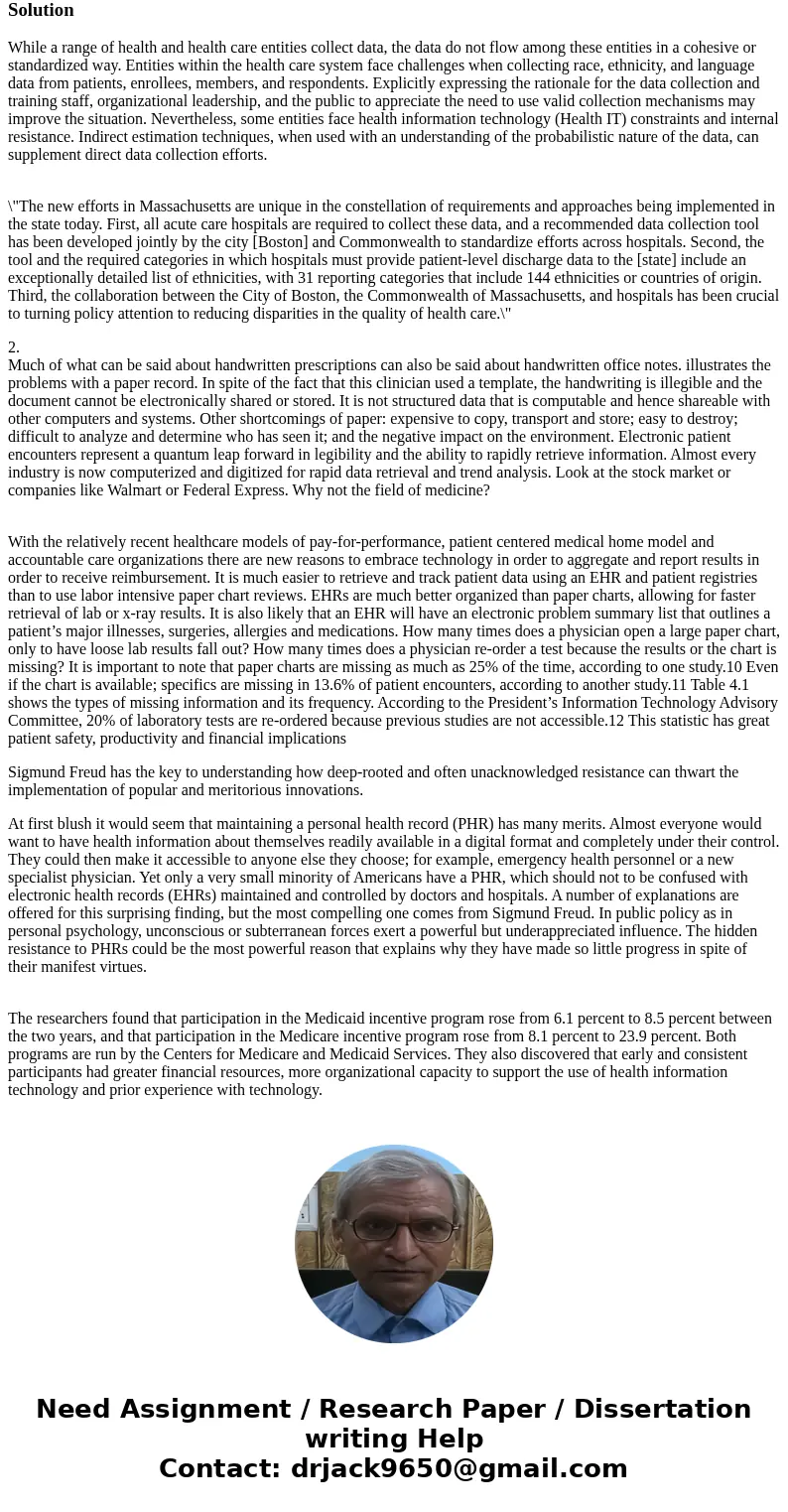Have we been successful in standardizing the health record i
Solution
While a range of health and health care entities collect data, the data do not flow among these entities in a cohesive or standardized way. Entities within the health care system face challenges when collecting race, ethnicity, and language data from patients, enrollees, members, and respondents. Explicitly expressing the rationale for the data collection and training staff, organizational leadership, and the public to appreciate the need to use valid collection mechanisms may improve the situation. Nevertheless, some entities face health information technology (Health IT) constraints and internal resistance. Indirect estimation techniques, when used with an understanding of the probabilistic nature of the data, can supplement direct data collection efforts.
\"The new efforts in Massachusetts are unique in the constellation of requirements and approaches being implemented in the state today. First, all acute care hospitals are required to collect these data, and a recommended data collection tool has been developed jointly by the city [Boston] and Commonwealth to standardize efforts across hospitals. Second, the tool and the required categories in which hospitals must provide patient-level discharge data to the [state] include an exceptionally detailed list of ethnicities, with 31 reporting categories that include 144 ethnicities or countries of origin. Third, the collaboration between the City of Boston, the Commonwealth of Massachusetts, and hospitals has been crucial to turning policy attention to reducing disparities in the quality of health care.\"
2.
Much of what can be said about handwritten prescriptions can also be said about handwritten office notes. illustrates the problems with a paper record. In spite of the fact that this clinician used a template, the handwriting is illegible and the document cannot be electronically shared or stored. It is not structured data that is computable and hence shareable with other computers and systems. Other shortcomings of paper: expensive to copy, transport and store; easy to destroy; difficult to analyze and determine who has seen it; and the negative impact on the environment. Electronic patient encounters represent a quantum leap forward in legibility and the ability to rapidly retrieve information. Almost every industry is now computerized and digitized for rapid data retrieval and trend analysis. Look at the stock market or companies like Walmart or Federal Express. Why not the field of medicine?
With the relatively recent healthcare models of pay-for-performance, patient centered medical home model and accountable care organizations there are new reasons to embrace technology in order to aggregate and report results in order to receive reimbursement. It is much easier to retrieve and track patient data using an EHR and patient registries than to use labor intensive paper chart reviews. EHRs are much better organized than paper charts, allowing for faster retrieval of lab or x-ray results. It is also likely that an EHR will have an electronic problem summary list that outlines a patient’s major illnesses, surgeries, allergies and medications. How many times does a physician open a large paper chart, only to have loose lab results fall out? How many times does a physician re-order a test because the results or the chart is missing? It is important to note that paper charts are missing as much as 25% of the time, according to one study.10 Even if the chart is available; specifics are missing in 13.6% of patient encounters, according to another study.11 Table 4.1 shows the types of missing information and its frequency. According to the President’s Information Technology Advisory Committee, 20% of laboratory tests are re-ordered because previous studies are not accessible.12 This statistic has great patient safety, productivity and financial implications
Sigmund Freud has the key to understanding how deep-rooted and often unacknowledged resistance can thwart the implementation of popular and meritorious innovations.
At first blush it would seem that maintaining a personal health record (PHR) has many merits. Almost everyone would want to have health information about themselves readily available in a digital format and completely under their control. They could then make it accessible to anyone else they choose; for example, emergency health personnel or a new specialist physician. Yet only a very small minority of Americans have a PHR, which should not to be confused with electronic health records (EHRs) maintained and controlled by doctors and hospitals. A number of explanations are offered for this surprising finding, but the most compelling one comes from Sigmund Freud. In public policy as in personal psychology, unconscious or subterranean forces exert a powerful but underappreciated influence. The hidden resistance to PHRs could be the most powerful reason that explains why they have made so little progress in spite of their manifest virtues.
The researchers found that participation in the Medicaid incentive program rose from 6.1 percent to 8.5 percent between the two years, and that participation in the Medicare incentive program rose from 8.1 percent to 23.9 percent. Both programs are run by the Centers for Medicare and Medicaid Services. They also discovered that early and consistent participants had greater financial resources, more organizational capacity to support the use of health information technology and prior experience with technology.


 Homework Sourse
Homework Sourse